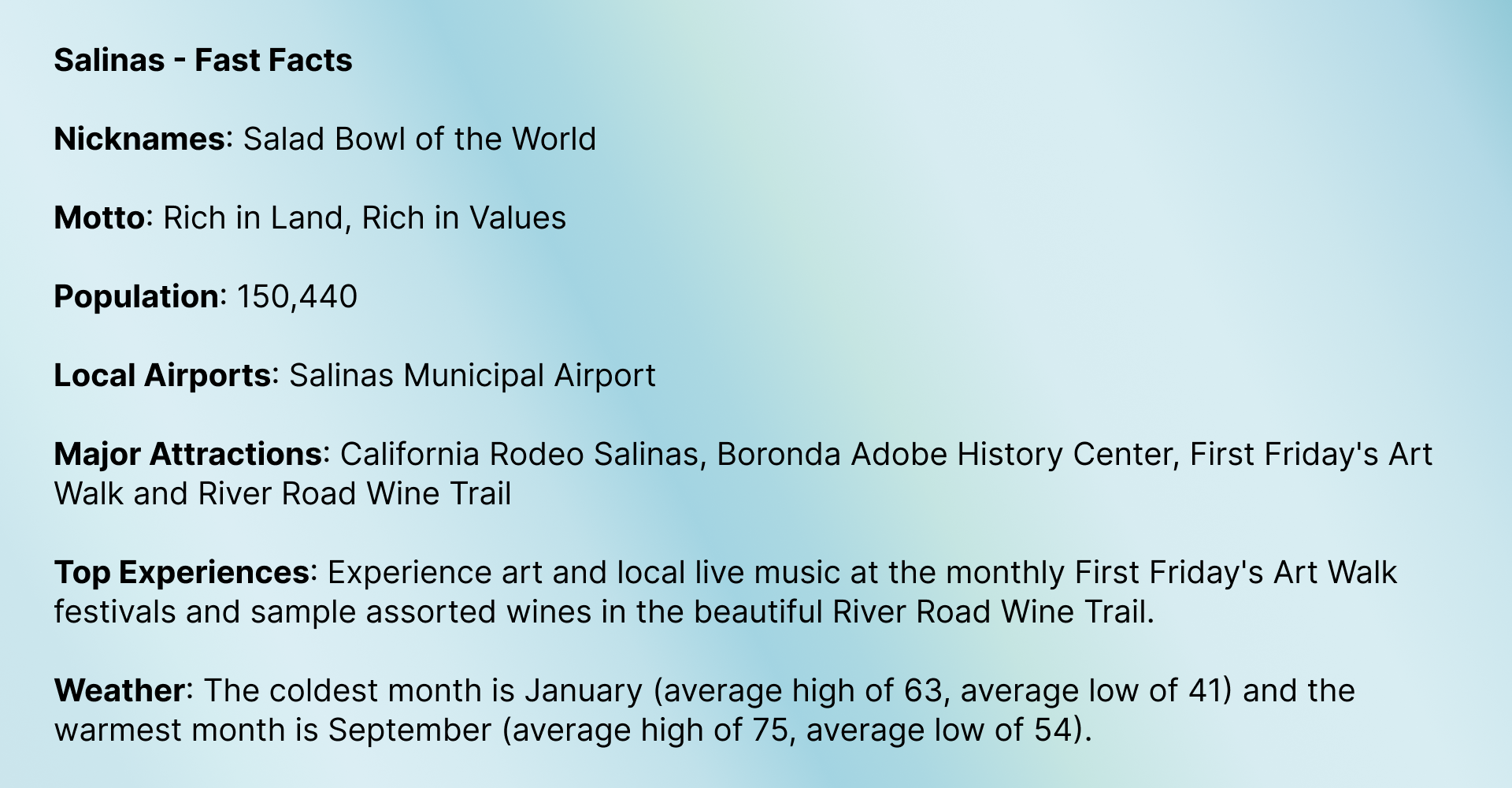 The birthplace of renowned author John Steinbeck and the setting of his acclaimed novel Of Mice and Men, Salinas is an agricultural city specializing in vineyards, the floral industry, and lettuce cultivation. The beautifully mild climate is ideal for farming as well as living!
The birthplace of renowned author John Steinbeck and the setting of his acclaimed novel Of Mice and Men, Salinas is an agricultural city specializing in vineyards, the floral industry, and lettuce cultivation. The beautifully mild climate is ideal for farming as well as living!
If you are planning an upcoming move to this city, read on for some helpful tips to settle into your new home with ease.
Salinas Climate
Salinas' weather is mild and cool, due to the moderating effect of the ocean air and fog from the Monterey Bay. This results in an even and pleasant Mediterranean climate throughout the year, with little variation in temperature from winter to summer. The average high in the winter is 63 degrees, compared to 75 degrees in the summer.
The city experiences heavy morning fog in the summer known as the "marine layer" due to the striking contrast of air and ocean temperatures. Average annual rainfall in the city is about 14 inches, with snowfall being relatively scarce--it occurs approximately once every 10 to 20 years.
If you are seeking a home unbothered by the detrimental effects of pollution, Salinas was named one of the top 10 American cities for cleanest air quality by the American Lung Association in 2012.
Salinas Neighborhoods
The historic downtown district, also known as Oldtown Salinas, is abundant with Victorian architecture, a variety of ethnic dining options, bars, boutiques, and culture. The city is the birthplace of Nobel Prize-winning novelist John Steinbeck, and he is immortalized by the National Steinbeck Center, located in Oldtown.
Other neighborhoods of the city include North Salinas, South Salinas, Harden Ranch, Creekridge, and East Salinas. The latter has a reputation for being relatively unsafe and a haven for gang-related crime, but other areas have been marred by gang activity as well. Be sure to thoroughly research any neighborhood before relocating.
Registering Your Car
Upon moving to the state of California, you have 20 days to register your vehicle. You will need an Application for Title or Registration signed by all registered owners as they appear on the out of state registration and/or title, your previous registration certificate, and smog and weight certifications if applicable. You will also need to pay the appropriate fees and have your vehicle inspected by the state DMV.
You have will have just 10 days to obtain your California driver's license, so make sure you get this out of the way as soon as possible after your move. You will need to complete the DL 44 application form, provide your Social Security number, show proof of identity and legal presence, pass vision and traffic law tests, give a thumbprint, and pay the appropriate fees. This process can be completed at any California DMV location.
Salinas Schools
Before relocating to a new city with children, it is important to conduct thorough research on the school system to ensure that they will provide your offspring with the best possible education. Salinas actually has seven separate school districts serving the city and neighboring communities.
The largest school district in the city is the Salinas Union High School District, which serves grades 7-12. The district is comprised of 10 campuses educating 13,600 students. The Salinas City Elementary School District is the largest grammar school system in Salinas, operating 13 facilities and serving 8,000 students. Other districts in the city include Santa Rita Union Elementary School District, Graves Elementary School District, Washington Union School District, Lagunita School District, and Alisal Union School District.
Salinas Employment
Often referred to as the "Salad Bowl of the World," the city is the world's largest supplier of lettuce. The majority of the workforce hold blue-collar jobs (55 percent), including jobs in manufacturing, fishing, farming, construction, maintenance, extraction, and forestry occupations. Common white-collar employment options include sales and office management. Unfortunately, the economy in the city is has been experiencing a loss of jobs and high unemployment rates--17.5 percent as of March 2013.
Major employers in the region include Fresh Express, Capital One, and local agricultural companies Tanimura & Antle, D'Arrigo Bros and Taylor Farms.
Living Costs in the City
If you are considering a move to a new city, it is always important to make sure you will be able to live within your means. Costs of living in the California city are somewhat high--30 percent greater than the national average. Utilities are about 30 percent greater as well, and groceries are 20 percent more expensive than the typical American city--even 6 percent higher than the state average. Healthcare costs are about 15 percent above average, transportation costs are ten percent above average, and housing is a staggering 76 percent greater than the national average.
The average one-bedroom apartment in the city goes for about $1300 a month, and two-bedrooms typically rent for around $1500 a month.
Salinas Moving Resources
There are many moving and storage companies located in Salinas that are waiting to help you relocate to your new home. Be sure to do your research and obtain estimates from several different services before choosing one for hire. You can compare online quotes from many different moving companies and other services to aid you in your move, whether you are coming from the next city or overseas. Visit the following pages here at Movers.com to get fast quotes for the following services:
Salinas Transportation
If you're wondering how you will get around your new city, local public transportation is serviced by Monterey-Salinas Transit. The bus routes shuttle passengers throughout the city and Monterey County, as well as neighboring California cities San Jose and Gilroy. There is also a Greyhound bus station in the downtown area for travel to more distant cities in California as well as the rest of the country.
If you plan to travel by car, US-101 is a road with which you will want to become familiar. This major highway connects the city to the rest of the Central Coast region, as well as the San Francisco Bay Area to the north and Los Angeles to the south.
Culture and Contemporary Life
The city has a vibrant emerging art scene, including galleries, live theatre and music. The First Friday's Art Walk uses business venues to display exhibits and host performances by local musicians in the Oldtown region the first Friday of every month. The Valley Art Gallery is the oldest in the city, and the @risK Gallery is the newest, displaying a variety of fresh and socially-aware exhibits. Public art, such as murals and sculpture, are also commonplace in the city.
If you prefer acoustics to visuals, the local music scene in the city is jumping, with many bars and nightspots featuring live shows. For your taste buds' enjoyment, visit Salinas Valley, the largest wine-grape producing region in California. Sample a variety of vintages along the scenic River Road at one (or more) of the 20 wineries in the valley.
Salinas Relocation Tips
-
Before making the relocation to this city, conduct thorough research on its neighborhoods before choosing one to live. Salinas has a growing gang problem, and some areas of the city may not be safe, particularly the East Side.
-
Change your address! Be sure to notify the post office of your forwarding address four to six weeks before your move to ensure that you don't miss any important mail.
-
Look for work before you arrive. The city has a high unemployment rate, so it would be a good idea to land a job before you make the trek to Salinas.